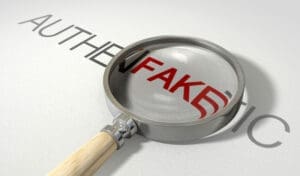Since ecommerce has evolved into a primary distribution channel, retailers are faced with the challenge of how to prevent counterfeit products from flooding the digital marketplace.
There are many examples of brands that have been victims of counterfeiting, and this is especially true for luxury brands that are sold online, and their customers are well aware of the issues. As a result, consumers around the globe are willing to pay premium prices to order products they know are being sold and shipped from western companies to ensure they are purchasing and ultimately receiving legitimate products. Unfortunately, there is a high probability that these higher paying customers will still wind up with counterfeit products. The implications don’t only cause loss of revenue for the manufacturers and retailers, but they also erode consumer trust in the brand itself.
 The supply chain is one of the most important areas that brands need to invest in to eliminate counterfeiting and to protect their brand image. By ensuring transparency and legitimacy of the supply chain from the beginning to end, manufacturers and retailers can eliminate some, if not all counterfeit-related risks. Tightly controlling the chain of custody and the flow of goods & materials used in the assembly of the final product allows brands to provide higher quality assurance and ultimately, legitimacy to their consumers. Without this, there is a real risk that products can be switched with counterfeits throughout the supply chain process.
The supply chain is one of the most important areas that brands need to invest in to eliminate counterfeiting and to protect their brand image. By ensuring transparency and legitimacy of the supply chain from the beginning to end, manufacturers and retailers can eliminate some, if not all counterfeit-related risks. Tightly controlling the chain of custody and the flow of goods & materials used in the assembly of the final product allows brands to provide higher quality assurance and ultimately, legitimacy to their consumers. Without this, there is a real risk that products can be switched with counterfeits throughout the supply chain process.
Depending on the product type, there are different standards of quality assurance and different implications. For example, with healthcare, food and cosmetic products, counterfeiting not only causes consumer dissatisfaction, but can also pose serious health issues – not the kind of press coverage these types of brands are looking for. In the case of cosmetic products, even if consumers are able to figure out that they were sold counterfeit products from an unreliable source, they may quickly develop lack of trust in the quality of the brand as a whole, resulting in additional future revenue loss.
Along with the loss of credibility comes damage to the brand image as consumers lose faith in attaining a real product and, moving forward, choose to purchase another brand that they believe has more reliable quality assurances. In their attempts to mitigate such risks, many companies that choose to sell products in locations where counterfeiting is widespread now include some type of traceability or verification. This allows consumers to look up where the products came from and whether or not it is a “real”, genuine product.
Lost revenue plays into the counterfeiting problem for obvious reasons. Every time a counterfeit product is sold, this represents lost revenue for the legitimate brand. There were predictions issued by the International Trademark Association (INTA) and the International Chamber of Commerce, saying that the global economic value or counterfeiting could reach as high as $2.3 trillion by 2022 compared to $1.7 trillion in 2015. Currently, China & India are the biggest contributors to the problem, largely due to the ecommerce distribution channel. Even as these countries take steps to reduce counterfeiting, it is expected that the counterfeiting will remain a problem in neighbouring countries.
For brands, manufacturers & retailers, the best way to address counterfeiting issues is to focus on improving the supply chain quality control, from manufacturing to final mile delivery. An experienced supply chain partner will be able to ensure transparency,
authentication and greatly increased quality assurance measures. This can be leveraged when advertising your brand and to ensure the products you are selling to your customers are exactly what they intended to purchase. The process of improving your supply chain also needs to include monitoring your online channels as part of the overall anti-counterfeiting strategy. There are many online marketplaces that offer counterfeiters the opportunity to sell their goods, so it’s important that you educate your team so they are aware of who is out there selling counterfeit items, and how they operate, as this leads to better counterfeit prevention.
The Canadian logistics landscape can be leveraged in your supply chain strategies to prevent product counterfeiting. Since many consumers overseas want to make sure that the products they are buying have a western label, many companies chose to ship their products from Vancouver. Vancouver has become the hub for shipping to and from Asia due to its geographic location. Some companies choose to dropship their products from Vancouver, and others choose to ship directly through companies like Canada Post or Purolator International.
When it comes to preventing counterfeiting for both online and offline distribution channels, quality assurance and careful monitoring need to be part of your supply chain strategy. A trusted 3PL like SCI can provide your team with an effective supply chain strategy that will ensure your brand is protected, and help implement it. Contact one of our logistics specialists today and let’s talk.